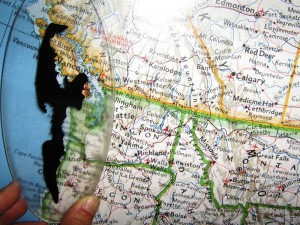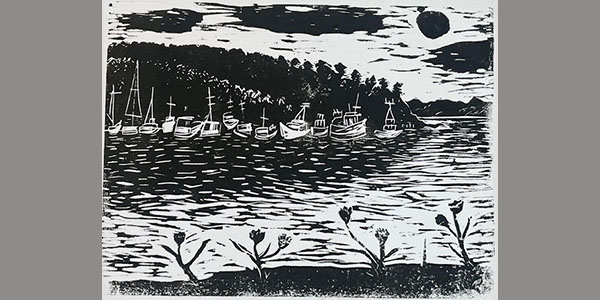
It can’t happen here? This is what the 1989 Exxon Valdez 11 million gallon crude oil spill looked like, transposed to the Strait of Juan de Fuca, Salish Sea and Pacific coast. (Reprint use only with permission from Orcas Issues.)
By Chom Greacen of Lopez NO COALition
San Olson, a former Naval Officer recently shared his ship expertise and perspectives on coal shipping risks with an audience on Lopez. Serving on the Steering Committee of SSASS, a trans-border coalition for the purpose of protecting the Salish Sea from adverse maritime impacts, Olson plans to bring his talks to San Juan and Orcas soon.
Here are ten eye-opening facts from his talk.
- The Pacific NW is becoming a world class fossil fuel transshipment center for Asian markets. There are currently over 2,000 transits by seagoing vessels in our waters, and 1,700 more if the Cherry Point coal terminal is approved and theVancouver tar-sands pipeline is expanded as planned. The more vessels plying our waters, the greater the potential for oil spills.
- Our islands are dead center in this shipping hubbub! All vessels carrying coal or oil from the eight existing/planed ports fromVancouverBC, to Cherry Point, and Anacortes pass through either Haro orRosario Straits; we are surrounded by major shipping lanes. .
- The passages around the SJ are narrow and hazardous.Rosario Strait shipping channel is only ½ mile. Haro strait is wider (1 1/8 miles) but at StewartIsland, ships must make a sharp turn in a channel less than 2 miles wide with a shoal and Arachne Reef just to the west. Several other shoals and reefs lie within ½-1 ¾ miles from middle of the two channels.
- Coal carriers, tankers and container ships are getting bigger and BIGGER and are thus trickier to maneuver. For comparison, a Post Panamax ship is equal to 34 Super Class (“Elwha”) ferries in gross tonnage, and longer than the largest aircraft carrier (over three football fields long). Big ships require great distances to turn or stop. If power is lost, the stopping distance would be on the order of 5-7 miles.
- Miscommunication could be an issue leading to maneuvering miscalculations since 75% of the ships in our waters are of Greek, Japanese, Chinese or Panamanian registry. The captain and mixed nationality crew may have limited understanding of English.
- All bulk carriers are single propeller, single-hulled (except the bottom for structural support) and are not required to have a tug escort. Each coal carrier may carry up to 2 million gallons of heavy oil as fuel. Oil spills from coal carriers do happen as in the recent case of a Chinese coal ship running aground in theGreat Barrier Reef, spilling 4 tonnes of oil in April 2011.
- 54% of “Ship Endangerment” situations are to due to engineering, rudder or propeller malfunctions. And 59% of the vessels which received High, Very High or Extremely High Risk Scores were bulk carriers, according to an inspection in 1995 by WA Office of Marine Safety. The trend is likely worsened since due to cost cutting measures on maintenance and crew.
- In event of navigational or engine trouble, the nearest designated rescue tug is at Neah Bay, 6-7 hours away at top speed. Our local oil spill responder, Islands Oil Spill Association (IOSA), could be rapidly overwhelmed by a spill from a large ruptured vessel.
- A hypothetical spill of 65,000 barrels (25% of largest expected outflow from a Suezmax tanker) in Rosario Strait area would cost $128 million, 2.6 times the SJ County’s 2011 budget. The modeled socioeconomic and environmental impacts include damage to private property, parks, commerce and mortality of wildlife (29,000 deaths from birds alone). Even without the horror of an oil spill, sound saturation from numerous transiting vessels interfere with social interactions, rearing of calves and searching for food of our resident orca.
- The US is subsidizing China’s use of coal. (BLM sells mineral rights toMontana coal at a fraction of world market price) and the CO2 emissions from burning millions of tons of coal will condemn our children and grandchildren to a much warmer and more violent climate.
The plan to export coal from Cherry Point seems like an ecological and economic time bomb for the San Juans and beyond. We have very little to gain and much to lose. The scoping process has just started. It’s time to act to register every concern we might have.
**If you are reading theOrcasonian for free, thank your fellow islanders. If you would like to support theOrcasonian CLICK HERE to set your modestly-priced, voluntary subscription. Otherwise, no worries; we’re happy to share with you.**








Chom,
Thanks for taking the time to help us understand the issues surrounding the Cherry Point Coal Terminal.
In addition to the sea lane threat, the coal terminal pollution, in the form of coal dust, threatens the marine eco-system, particularly the herring population, which is a critical part of the food chain supporting our salmon fisheries… Coal is a dirty business both on land and sea.
Great article… thank-you Chom, and San. This all said, (and I couldn’t agree more with Fred Klein’s post from the other day on this subject)… What meaningful efforts can we as individuals make instead of just making phone calls and signing petitions? I feel the outrage on this and many other issues, but this is only furthered by the knowledge that these types of decisions boil down to a few people behind closed doors… for money. As usual, it’s a lot of people against a lot of money. Our environment, (that which allows us to live), should mean more to us. It does not bode well for us locally, statewide, or as a country that there is seemingly no meaningful dialogue regarding environmental issues from anybody currently running for political office (not here or anywhere). Not the type of leaders I want. Our corporate government has reduced everything down to a commodity (including our own genes)… if it’s not profitable it’s not on the table. What kind of thinking is…